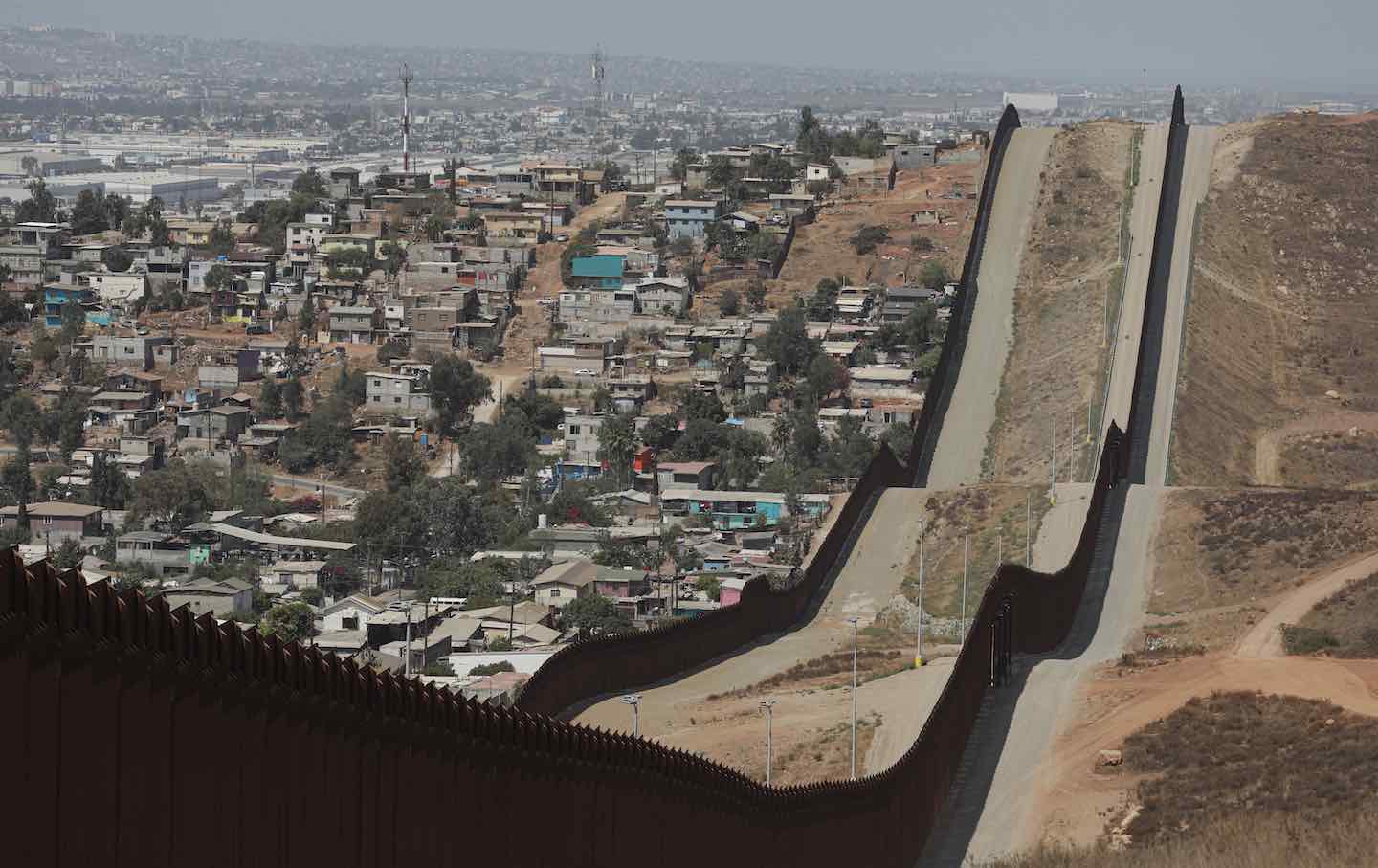Imagining a World of Open Borders
John Washington’s compelling new book lays out the case for abolishing the hellish idea of the border.

View of the US-Mexico border wall in Otay Mesa, California, 2021.
(Photo by Sandy Huffaker / AFP via Getty Images)
Since 1995, the countries in the Schengen Area—a geographic and political designation that encompasses most of the European Union’s member states—have opened their borders to one another. The ease of movement between, say, France and the Netherlands, or Germany and Italy, was seamless for a period of three decades. But the promise of that free movement has been weakening for years: As migrants and refugees from North Africa and Syria have attempted to make their way to Europe, border security has rapidly increased in both intensity and scale. Finally, this January, border checks were reinstated or extended in a number of Schengen states. (France, for instance, has reintroduced them with all Schengen countries until October 31.) The border checks were touted both as a response to an increased terror threat and, particularly in Southern Europe, as a response to the influx of undocumented migrants seeking passage from the Mediterranean through the region to the relatively high-wage zones of northern and western Europe.
Books in review
The Case for Open Borders
Buy this bookIn April, the European Parliament adopted a series of legislative reforms to the EU’s migrant policy. Among other changes, the new legislation requires member states’ border officials to take and store the biometric data of every migrant over the age of 6 who has not already been approved for entry into the EU, and it fast-tracks asylum determinations at detention centers for migrants from countries whose asylum claims are commonly rejected (which human rights groups have warned will result in increased detentions, deportations, and the loss of due-process rights).
The closing of Europe’s borders, and its increasingly hostile stance to migrants, mirrors a similar process playing out in the United States. In June, President Joe Biden issued a dubiously legal executive order—utilizing the same legal mechanism that Donald Trump used to create the “Muslim ban”—that would effectively shut down the southern border to asylum seekers. At August’s Democratic National Convention, presidential nominee Vice President Kamala Harris promised to sign the “strongest border bill in decades” into law—“the border patrol endorsed it,” she stated to raucous applause.
The inviolability of the border, then, emerges as a powerful constant in Western politics, a symbolic order upon which fears of waning sovereignty and internal political and economic crises can be projected. Even if there may be disagreement on a state’s responsibility to migrants and refugees, all establishment parties seem to agree that the border must be “defended” and that border regimes must be enforced, even to the detriment of other human rights and international commitments.
In The Case for Open Borders, writer and immigration reporter John Washington offers a different solution: open the borders, all of them. Borders, Washington deftly argues under four modes—the historical argument, the economic argument, the political argument, and the environmental argument—fill both an ideological and a material role in the global order, as defined by, and largely to the benefit of, the West (though non-Western powers like China enjoy certain benefits as well). The book arrives at a time when borders are, as Washington writes, “simultaneously creeping outward and boring intimately inward, increasingly infiltrating everyday life.”
This “pernicious and paradoxical concoction of both limitlessness and strict limits” can be clearly seen, Washington argues, in the “bizarre disruption of the tomato industries between Italy and Ghana.” Ghana is one of the world’s largest importers of tomato paste, with the imports increasing over 1,000 percent between 1996 and 2015. But prior to this stunning rise, Ghana was home to a large, stable tomato industry. So what happened? “Free trade” happened. The rapid destruction of Ghana’s tomato industry came “after the World Trade Organization (WTO) pushed Ghana…to dramatically lower import tariffs,” which opened “space for subsidized foreign vegetables to decimate the local industry.” The structural adjustment forced Ghanaian farmers to seek work elsewhere, many in Italy. These farmers who once grew tomatoes in Ghana now grew them in Italy, to be shipped back home to further erode the country’s domestic agricultural market. Many of these migrants, Washington notes, “live in segregated clusters of shacks outside of towns where they have limited or no access to running water, electricity, or health care.”
The gutting of the Ghanaian tomato industry not only resulted in the expansion of the Italian and Chinese markets (the two main exporters of canned tomatoes to Ghana) into new territory, but also, and equally as important, resulted in a fresh supply of cheap, hyper-exploitable labor in the form of dispossessed and unemployed Ghanaian farmers. This “modern form of peonage,” as Washington calls it, depends on the harsh enforcement of the border system for its functioning: Workers from the Global South who migrate to the Global North in search of opportunity, like the Ghanaian tomato farmers, are kept in check by the threat of deportation, “shackled to their work permits, which bosses can use as a form of blackmail.”
To open the borders, then, would remove one of the key tools in this system of exploitation. It would also, Washington argues, be a boon to whichever country ceased to deport their migrants. In the United States, undocumented migrants pay over $11.7 billion in state and local taxes each year, and all immigrants consume roughly 40 percent less in public-benefits value per capita than so-called “natives.” The numbers are similar for refugees and asylum seekers, as a 2017 Department of Health and Human Services study found, the publication of which was quashed by the Trump administration.
Migrants not only fill jobs at a time where most states are experiencing a jobs surplus (i.e., they have more openings than they can fill) but also, according to a 2007 study by the economist Giovanni Peri, boosted wages by around 4 percent for the average native worker. The average cost for deporting a single migrant as of 2016 is $10,854, no doubt inflated due to the Department of Homeland Security’s outrageous budget. The net effect of deportation on targeted communities—to say nothing of the deported migrants themselves—is overwhelmingly negative: Wages, production levels, and commercial spending all decrease.
Still, the net benefit of migrants to the economy is attributable, at least in part, to their status as underpaid and politically unrepresented workers. “Despite what fearmongers would have you believe,” Washington writes, “undocumented migrants are also ineligible for most federal welfare benefits,” such as SNAP, Social Security, and Medicare or Medicaid. This inability to access federal benefits goes some way toward producing the disparity of the public burden between citizen and migrant. Washington asserts that “the drawing of a border delineates not the edges of the community but three separate classes: one population is taxed and has services rendered to them; another population (noncitizen legal residents) is taxed but receives fewer benefits; and another population (undocumented migrants) is exploited, offered scarce benefits, and sometimes imprisoned and expelled.”
In any event, Washington’s heart is just not in the economic argument for open borders: “We should open borders because it’s good for people…[not] because of the GDP.” Washington’s political argument, however, is less about the ways in which open borders are “good for people” and more about the ways in which borders themselves are the product of physical and cultural violence—one that requires the constant continuation of that violence for their maintenance.
Since the North American Free Trade Agreement (NAFTA) took effect in 1994, the border has steadily become more militarized and, as a consequence, more deadly. The militarization of the border can be seen, on the one hand, in economic terms, but it also serves an important ideological purpose. The specter of terrorism is frequently deployed to justify crackdowns on illegal migration and the construction of a more militarized border, but as Washington points out, there has never been a terrorist attack carried out by someone who illegally crossed the southern border. In fact, only seven people who entered the United States illegally have ever been convicted of planning terror attacks on US soil. Border militarization, then, is intended to provoke “the very fear it’s meant to quell.”
We might call the border the embodiment of the death drive of Western (and particularly American) politics. As Washington writes, Michael Walzer “famously claimed that nations must maintain a ‘community of character’ and thus be allowed to deny entry to migrants. Otherwise, he fears, citizens will become ‘radically deracinated’ from their territory and culture.” But, Washington continues, the so-called character of these nations are themselves the product of long, violent processes of dispossession and forcible assimilation. The nation is always already a “radical deracination” of those in its territory.
National character is not a static entity but rather a continual process in which a multiplicity is forged into a contrived unity. The destruction of various dialects and Native languages, of Indigenous folkways and religious practices, of cross-cultural exchange: This is the origin of the nation. Raphael Lemkin, the lawyer responsible for coining the term “genocide,” included the crime of cultural genocide in an early draft of the United Nations’ Genocide Convention. The inclusion of cultural genocide in the finally adopted draft was rejected by the United States and a number of other Western nations. Many scholars believe that the United States’ motivation for rejecting the article was, in no small part, self-defensive in light of the ongoing cultural genocide of Native Americans.
Other delegations joined in the rejection of the article and more directly acknowledged their colonial motivations for doing so: As the political scientist Shamiran Mako points out, “The Swedish delegation…raised serious concerns that Sweden might be accused of cultural genocide due to the country’s education policy toward minorities as well as the government’s forced conversion of the Lapps to Christianity,” while “the representative of New Zealand also opposed the inclusion of a cultural genocide clause, arguing that it interfered with the Trusteeship Council’s efforts at civilizing the indigenous inhabitants of the Tanganyika regions.”
The nation is not an innocent or natural association of people but often the product of cultural genocide. At its core is a desire for internal homogeneity, which, in order to be maintained, turns into a desire for stasis as well—a state of being the border is supposed to uphold. The border, and the desire for stasis and control to which it gives material form, becomes a load-bearing psychic element. The more undemocratic that society becomes under the aegis of a global capitalism that always seems to pick the same winners and losers, the more the neuroses spurred by this loss of control are projected onto the border, the international symbol of control—and the more this fear is projected, the more the border becomes psychically necessary. It is a feedback loop with deadly consequences.
Popular
“swipe left below to view more authors”Swipe →Washington’s book might best be read as a jeremiad against the very notion of borders, but his ideas for achieving his political vision ring a bit hollow in comparison to the weight of the evidence he offers against borders in the first place. In the last third of the book—“How Do We Get There?”—Washington offers a number of proposals ranging from the concrete and technocratic to the revolutionary and utopian. In terms of the first, Washington proposes the eradication of for-profit immigration detention, which is a relatively new phenomenon, beginning in 1983 with the first private prison company, Corrections Corporation of America. The mass incarceration of migrants is a new phenomenon as well: “As recently as the 1960s,” Washington writes, “immigration detention was practically abolished. In 1970, less than 600 people in the United States were charged with an immigration crime. And as recently as 1993, less than 2,500 people were charged with immigration crimes. By 2018, the number rose to nearly 110,00.”
Like the US prison and jail system, immigration detention centers are sites of incredible violence and outright torture (migrants are notoriously packed into “freezing cold dungeons known by migrants as hieleras,” or “iceboxes,” while they await processing). Washington aptly points out that any organizing against private detention would be most fruitful on the municipal basis, as county and city governments retain the ability to cancel their contracts with private detention companies and with US Immigration and Customs Enforcement (ICE). How such organizing and political pressure ought to take place, however, is left vague: “Holding politicians to account to fulfill campaign promises” is somewhat circumspect as a strategy, but it is given a bit more substance when Washington cites “direct action and protest, as activists have already shown through successful sabotage operations against the US-Mexico border wall and interruptions of deportations” that we need not exclusively appeal to our elected representatives’ better angels.
In the same vein, Washington also proposes the abolition of ICE—or, barring that, the reduction of its duties and the disarmament of its agents. Even though migrants commit crimes at significantly lower rates than “natives” (who are “2 times more likely to be arrested for violent crimes, 2.5 times more likely to be arrested for drug crimes, and over 4 times more likely to be arrested for property crimes,” Washington writes), individual instances of crime committed by migrants are peddled by right-wing and liberal media alike in order to drum up support for harsh border policies. This has led to the militarization of ICE and US Customs and Border Protection and the extension of the Department of Homeland Security’s reach into communities across the country (which “has gone so deep,” Washington writes, “that in one town in Maryland, after a series of fights at the local high school, administrators reached out to Homeland Security officials to monitor students’ social media accounts”).
What it has not led to is a reduction in illegal crossings (“the undocumented population increased by about 70 percent from 7 million to 12 million in the first decade of the agency’s existence”) or any modicum of safety for communities on the border or, notably, in the migrants’ countries of origin as well. As Washington points out, the MS-13 and Barrio 18 gangs were both created in Los Angeles and only took root in Central America—where they were able to consolidate their power, establish themselves in the drug trade, and then move back to the United States—after years of mass deportations. The border produces the very problems it is ostensibly designed to solve. In order to claw back some of ICE’s capacity for violence and repression, Washington suggests that we militate for stripping Border Patrol agents of their weapons, submitting agents to independent review, and retraining those not fired for misconduct to conduct remote rescues, “care for and restore ecosystems, and…form part of a new Civilian Climate Corps.”
Other proposals include the establishment of border-town citizenship, a special legal status that would give the residents of border towns, on both sides of the border, voting rights in regard to certain issues; the decriminalization of unauthorized border-crossings; and the establishment of a free-transit zone between the United States, Canada, and Mexico, with eventual expansion to Central America as well. On this last point, Washington curiously—because of the horrific effects of NAFTA that he so convincingly outlined earlier in the book—suggests adding Central American countries to NAFTA and then welding “the concept of free migration to free trade.” Even if free transit were possible across open borders, the economic degradation wrought upon Central America by the US would continue. The higher wages of the United States would still attract migrants who could still be abused, and cheap, federally subsidized goods (such as corn or soy) would continue to flood into the region. There are good reasons for the United States to have open borders, but there are also good reasons for other countries to keep the United States out.
Still, borders are core components integral to the functioning of global capital and our rotten world order, and so, in one way or another, they constrain us all. It is telling that the US Border Patrol’s mobile surveillance towers were “previously named ‘Cerberus,’ after the three-headed hound of Greek mythology that prevented people from escaping the underworld.” Borders, wherever they are, are a hellgate—maintained by violence, separating the geographically blessed from the damned. But, crucially, the Cerberus towers monitored people on both sides of the southern border; the blessing of geography only goes so far. Republican politicians love to say that “every state is a border state,” and in a sense, they’re right. The border—its tactics and agents of repression, its zero-sum logic of competition, its hatreds and dehumanizations—extends over the continent, over the world. The preservation of borders in the face of climate catastrophe, global conflict, and regular economic crises will require ever greater internal and external violence. The same Texas Department of Public Safety that brutalized students at UT Austin protesting against the Gaza genocide also brutalizes migrants along the southern border. Like the imperial boomerang, the border always comes back home—which is to say, we’re all trapped in hell together, and only together can we escape.








